This page is for personal, non-commercial use. You may order presentation ready copies to distribute to your colleagues, customers, or clients, by visiting https://www.parsintl.com/publication/autoblog/
It takes equal parts guts and capability to keep the throttle mashed even when you’re not entirely sure what terrain lies ahead of you. That suddenly occurred to me while barreling through the brush-filled desert near Palm Springs, Calif., while driving the 2023 Ford Bronco Raptor at around 60 miles per hour through whoops that would swallow the average crossover whole. The more I thought about it, though, the more I realized “guts” is really a very small part of it. What you need, in all actuality, can be better described as “trust.” After only two days driving the new Ford Bronco Raptor, I had developed enough trust in the vehicle’s capabilities that I felt confident I could keep the throttle mashed, the terrain be what it may.
And yes, I did indeed keep the throttle mashed, over hill and dale and brush and bump. Needless to say, both I and the Bronco Raptor survived unscathed, minus a solid layer of dust that coated everything from the vehicle to my helmet and jeans. With apologies to J.M. Barrie, “Second exit to the right and straight on ’til Baja.”
Let’s be clear right off the bat. Unless you’re a regular King of the Hammers competitor, the Ford Bronco Raptor is capable of much more than you are as a driver. Proof positive is the fact that I was actually piloting the thing over terrain that made up parts of the last KOTH race on Means Dry Lake at Johnson Valley. Our route included several miles of high-speed action over sand and rock, along with slow and deliberate climbs, and descents over boulders bigger than the Bronco itself.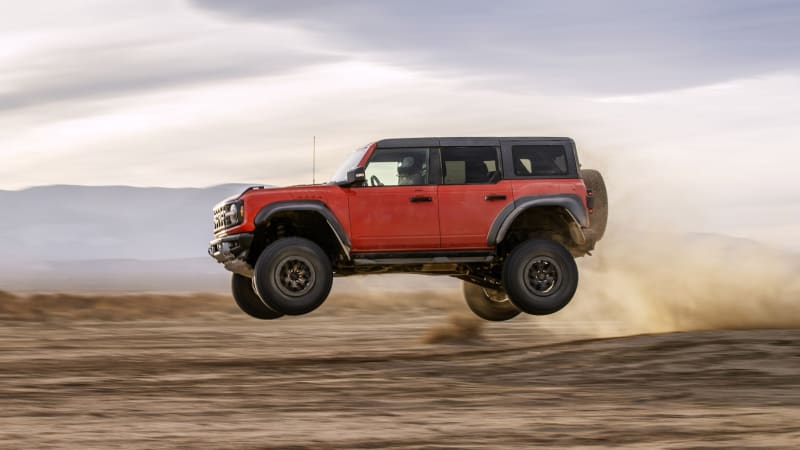
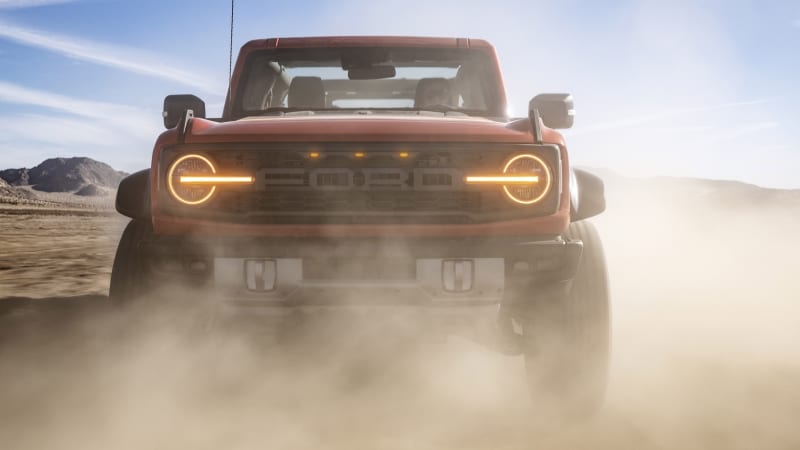
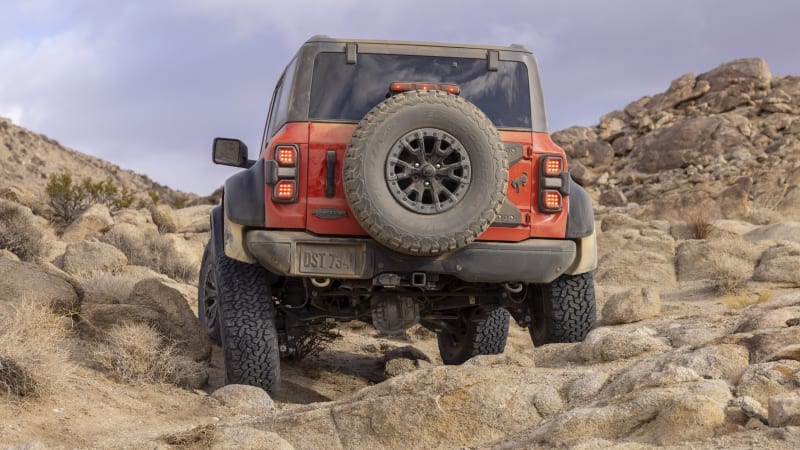
And that’s saying something, considering just how imposing the Bronco Raptor is. Besides the obvious aggressive bits, including the Raptor-specific grille, fascia, front and rear lighting signatures, and fully functional vents in the hood and front fenders, it’s almost comically wide. The track width extends 8.6 inches past the standard Bronco, and overall width is up even a bit further than that. Everything about the Bronco Raptor is harder-core than lesser models, from the fully boxed frame with new shock towers and several reinforcements to the B- and C-pillar reinforcement bars. Ford says the Raptor is 50% more torsionally rigid than the base Bronco platform.
The two main components that turn the Bronco into a Raptor are its suspension setup and its powertrain. The former offers 13 inches of front travel and 14 inches at the rear. Propping it up are Fox-branded 3.1 Internal Bypass Semi-Active Dampers, with the rear benefiting from remote reservoirs. Sensors, including a set that monitors how much travel is left, allow the dampers to adjust hundreds of times per second to match the vehicle’s terrain requirements. The same axles that Ford designed for its Bronco DR race truck are used in the Raptor: the front based around a Dana 44 AdvanTek and the rear built on a Heavy Duty Dana 50 AdvanTek drive unit. Combined with 37-inch BFGoodrich K02 All-Terrain tires on 17-inch beadlock-capable wheels, those axles allow the Bronco Raptor to offer a minimum of 13.1 inches of ground clearance.
On to the powertrain. A 3.0-liter twin-turbocharged EcoBoost V6 is tuned to provide 418 horsepower and 440 pound-feet of torque. It’s not the exact same powerplant used in other Ford and Lincoln vehicles, though it’s certainly related. Its unique induction and intercooler systems are designed to deal with hot and dusty environments, which came in handy in the 110-degree dry lake beds we plowed through. A 10-speed automatic transmission sends the ponies to all four wheels through a transfer case with a 67.7:1 crawl ratio and on to locking differentials front and rear. That front locker was absolutely crucial to conquering the boulder-strewn rock climbing exercises we put it through. Also appreciated were the side steps that are removable with just a handful of bolts, leaving full rock rails to protect the Bronco Raptor’s rockers from rock-size damage.
There are a few noteworthy upgrades inside the Bronco Raptor, too. The seats have some bolstering, though we still had to hold ourselves in on really high-speed off-roading sections. There are orange highlights all over, including on the steering wheel, vents and, optionally, the seat belts. A fully digital gauge cluster sits directly in front of the driver, and it’s configurable with a few different looks. The Performance View that puts a big digital tachometer front and center seemed to be the best choice. While driving off pavement, useful gauges can show the drive mode, pitch and yaw angles, and a whole lot more.
Like other Bronco models, a dial on the console is used to switch between GOAT (Goes Over Any Terrain) modes. In addition to obvious ones like Normal, Slippery, Sport and Off-Road, the Bronco Raptor features a Tow/Haul mode (and trailer towing is up from 3,500 pounds on other Broncos to 4,500 lbs on the Raptor), Rock Crawl and the Raptor-exclusive. Owners can set up their own mode with tuning adjustments offered for the steering, suspension and exhaust. At the top of the dash are buttons for activating or deactivating the sway bar, locking the differentials and activating trail turn assist.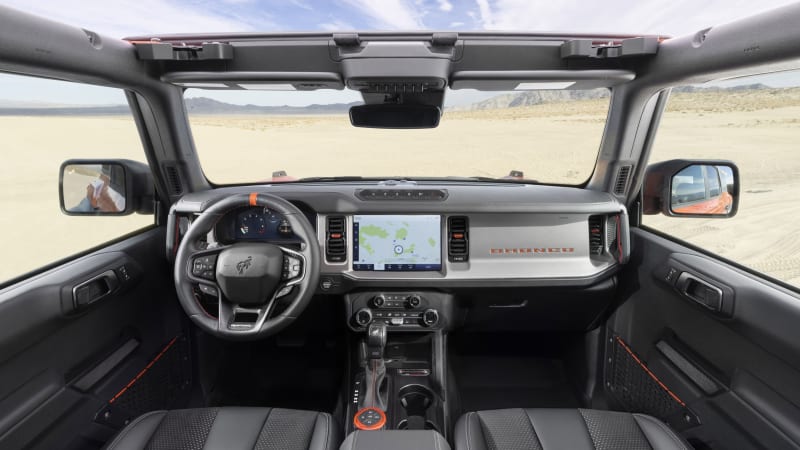
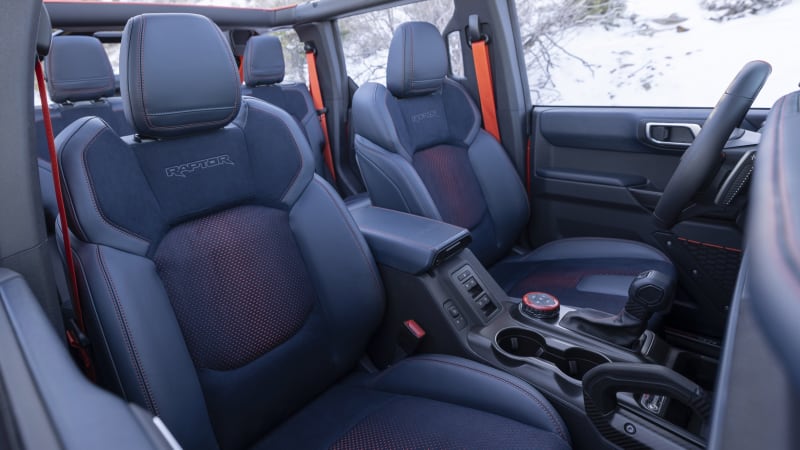
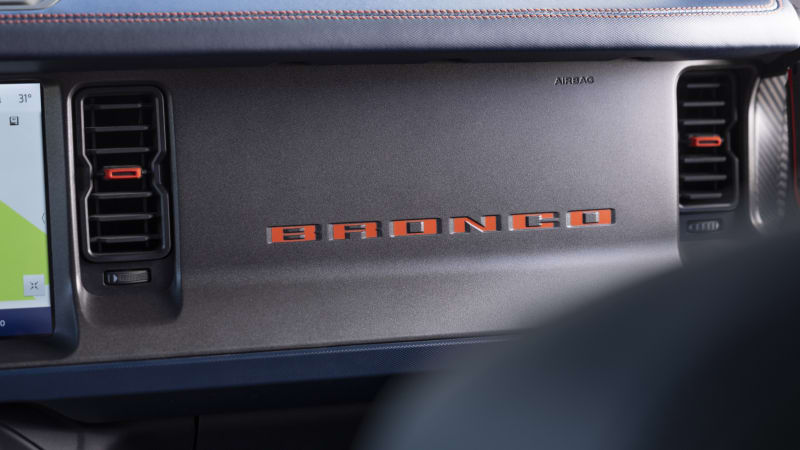
I’ve mentioned speeding across dry lake beds and rock crawling at as close to zero speed as possible. To say that the Bronco Raptor’s diverse capabilities impressed would be an understatement. There are barely any off-road situations it isn’t equipped to tackle, with one exception. Because it’s so wide, it’s not particularly well suited to backwoods trails where fitting between tightly spaced trees or rock outcroppings would be necessary. Past that, you can consider this Bronco Raptor the ultimate in off-road performance in America.
After mashing the throttle, there is a brief moment of turbo lag, but boost builds swiftly and 60 mph comes up quickly, even on low-traction surfaces. In most aggressive modes, the transmission holds gears until the last bits of space left on the tach, and some shifts, particularly the 1-2 transition, can be jarring. That’s especially problematic at crawling speed. Halfway through the drive, I started using the steering wheel-mounted paddles to shift up a gear, which wasn’t really any less jarring but, at least, was timed so as not to disrupt the drive.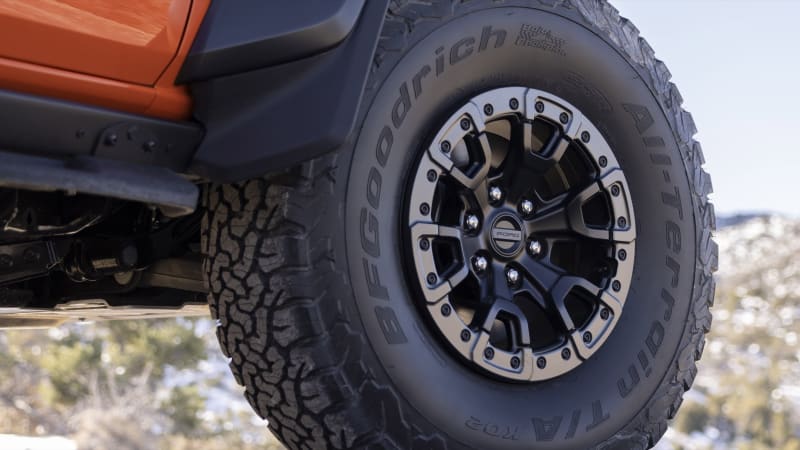
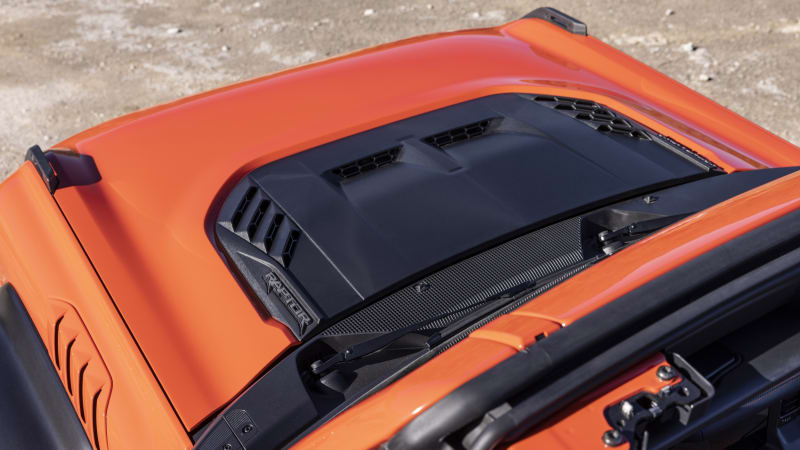
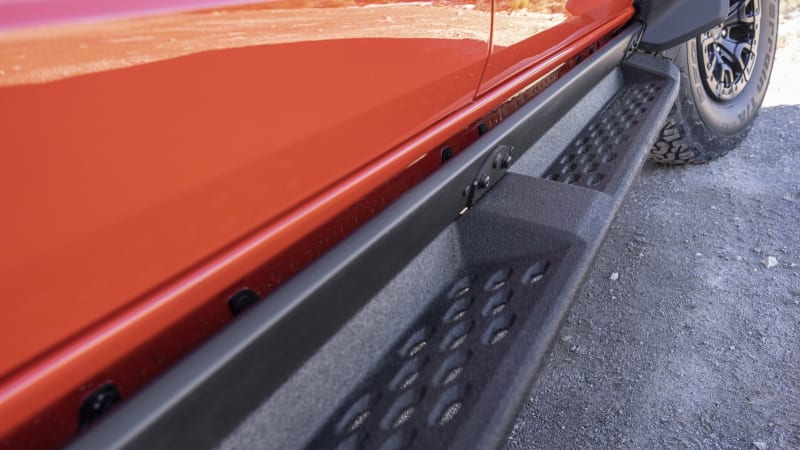
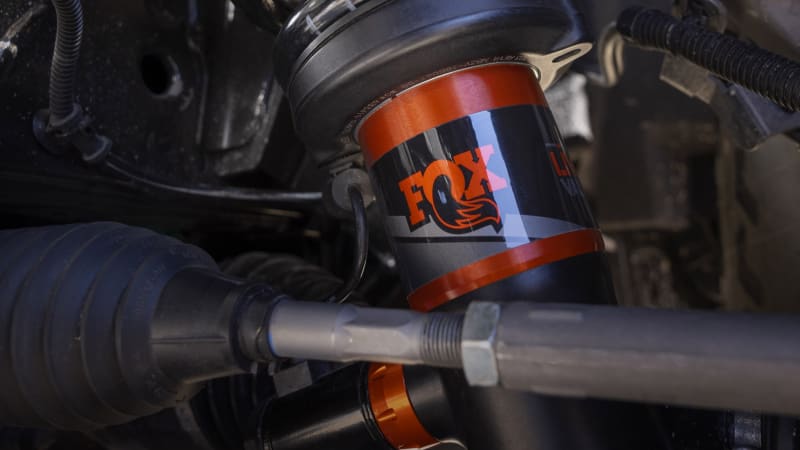
The most fun I had behind the wheel was in Baja mode. At speed, the Bronco Raptor’s long-travel suspension setup absolutely shreds through rough terrain. The somewhat clunky low-speed gear shifts aren’t an issue when bombing across the desert, and neither is the slight turbo lag. It’s in this environment where the Bronco Raptor feels absolutely dialed-in.
All of that off-road prowess doesn’t come cheap. The Bronco Raptor starts at $69,995 including destination. And it’s thirsty, too, with EPA estimated ratings of 15 miles per gallon city, 16 mpg highway and 15 mpg combined. If you insist on comparing it to something else, the Jeep Wrangler 392 costs $76,395 and offers 13 mpg city, 17 mpg highway and 14 mpg combined. Put simply, neither of these off-road specialists is friendly on the wallet at the initial purchase or at the fuel pump. And given their intended missions, that hardly seems to matter. Driven flat out on pavement, the Wrangler 392 is likely to be quicker in a straight line, and its torque-rich V8 engine jumps off the line with more oomph than the Bronco Raptor’s turbocharged six.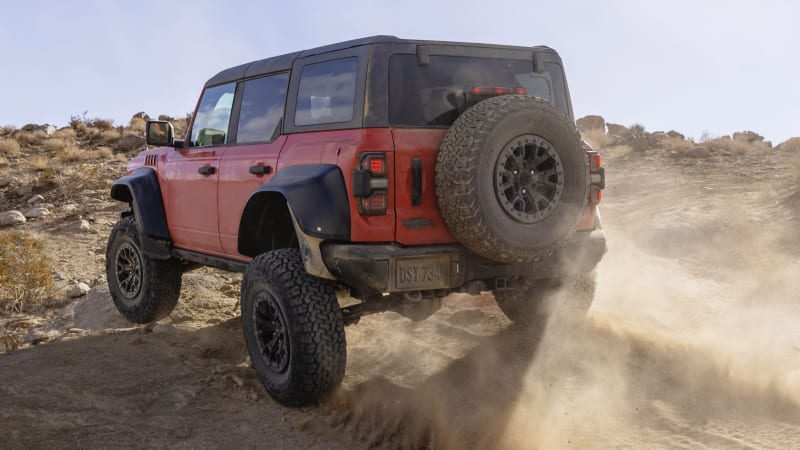
I did drive the Bronco Raptor on the street, of course, both on boring highway stretches and on twisty two-lane up and down the side of a mountain range. It’s surprisingly fun to drive, and Sport mode is tuned very well for high-speed driving. Of course, its steering isn’t sports-car sharp, and those big tires with their massive sidewalls don’t offer much grip on asphalt, but the Raptor never feels squirrelly or ponderous, and the Sport mode therefore doesn’t seem like a dumb gimmick. On roads that would make driving a Jeep Wrangler — including the 392 — at speed feel like a punishment, the Bronco Raptor puts a smile on your face.
And that’s a good thing, because an infinitesimal number of Bronco Raptor owners will ever push their vehicles off road to the point where it will be challenged. I certainly wouldn’t. At some point, some YouTuber will put up a video of a broken Bronco Raptor, but it’s going to take something really dumb to break it. For every mile spent on terrain like that of the Johnson Valley OHV area, a thousand of them will pass on pavement. Or more. But that doesn’t really matter. The Bronco Raptor is a stunning achievement, and bravo to Ford for having the gumption to build it.
Related video:
Autoblog accepts vehicle loans from auto manufacturers with a tank of gas and sometimes insurance for the purpose of evaluation and editorial content. Like most of the auto news industry, we also sometimes accept travel, lodging and event access for vehicle drive and news coverage opportunities. Our opinions and criticism remain our own — we do not accept sponsored editorial.
Please sign in to leave a comment.
GM to offer U.S. Buick dealers buyouts
The next big battery material squeeze is old batteries
Junkyard Gem: 1999 Audi A4 1.8T Avant Quattro
Junkyard Gem: 1993 UMC Aeromate Food Truck
QuietKat Jeep E-Bike Review: Go almost anywhere on two wheels
Here’s what a rental Tesla Model S interior looks like after 19,000 miles
News, Reviews, Photos, Videos
delivered straight to your in-box.
Thanks for subscribing.
Check your in-box to get started.
More Info
You must be logged in to perform that action.
Please enter a display name
